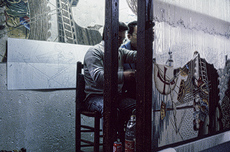UNITED STATES OF AMERICA
The Metropolatin Museum of Art
The word tapestry is now widely used to describe a range of textiles, including needlepoint and certain mechanically woven, ribbed fabrics, but historically and technically it designates a figurative weft-faced textile woven by hand on a loom. In European practice, the loom consists of two rollers, between which plain warp threads (the load-bearing threads) are stretched. In the large-scale production of centers in France and the Low Countries (modern-day Belgium), the warps were made of wool, although linen was also used in more artisanal production in Germany. Depending on the orientation of the loom, the warps are stretched vertically on a high-warp loom or horizontally on a low-warp loom; in both cases, the weaver works on the reverse side of the tapestry. The warps are arranged so there is a small space between the even and odd warps, called the shed, through which the weaver passes the colored weft threads that are wrapped around a handheld shuttle. Alternate warps are attached to drawstrings with which the weaver can pull them forward (on the high-warp loom) or backward (on the low-warp loom) to create a second shed, through which the weft is then passed back again. By passing the weft back and forth through the two sheds, the weaver inserts the weft over one warp and under the next in one direction and then back in the opposite direction over and under the alternate warps. Periodically, the weaver beats down the developing web so that the warps are completely covered by the weft.
Nowadays, the weft threads are primarily made of finely twisted wool, but in the past, finer tapestries also included silk and gilt-metal-wrapped silk. By varying the colors of the weft, the weaver creates a pattern or figurative image. Between 1400 and 1530, Flemish weavers developed the ability to reproduce an extraordinary range of surface textures and painterly effects through the use of finer and finer interlocking triangles of color (hatchings or hachures), the juxtaposition of different materials, and the use of different techniques to link the weft threads; compare, for example, Scene from the Trojan War (52.69), Triumph of Fame (1998.205), Last Supper (1975.1.1915) and Bridal Chamber of Herse (41.190.135).
The Textile Museum is dedicated to furthering the understanding of mankind's creative achievements in the textile arts. As a museum, it is committed to its role as a center of excellence in the scholarly research, conservation, interpretation and exhibition of textiles, with particular concern for the artistic, technical and cultural significance of its collections. The mission is pursued through development and maintenance of collections, records and a library, as well as through scholarly research, exhibitions, publications and educational programs. In all of this, the standard of excellence established by the Museum's founder, George Hewitt Myers, will be maintained.
n 1925 George Hewitt Myers founded The Textile Museum with a collection of 275 rugs and 60 related textiles drawn from the traditions of non-Western cultures. With the establishment of The Textile Museum, Myers demonstrated his commitment to championing the appreciation of textiles as works of art. At the time of his death in 1957, his collection numbered 500 rugs and 3,500 textiles. Since then, the Museum has broadened its' holdings to better represent the full spectrum of non-Western textile arts. Today the Museum's collections number more than 18,000 objects and span 5,000 years, dating from 3,000 B.C.E. to the present.
Arizona State Museum.
- is the oldest and largest anthropology museum in the Southwest, established in 1893.
- is an affiliate of the Smithsonian Institution.
- is the state's official archaeological repository and the largest non-federal archaeological repository in the country.
- administers Arizona's Antiquities Act and assists state & federal agencies in enforcing related legislation and repatriation; issues permits for archaeological and paleontological projects across the state.
- is the University of Arizona's anthropology museum and is one of the oldest research units on the campus.
- houses the only museum conservation laboratory in the state.
- hosts researchers from around the world who use the collections to expand the frontiers of knowledge in archaeology, ethnology, and history.
The J. Paul Getty Museum seeks to further knowledge of the visual arts and to nurture critical seeing by collecting, preserving, exhibiting and interpreting works of art of the highest quality. To fulfill its mission, the Museum continues to develop its collection through purchase and gifts, complementing its impact through special exhibitions, publications, educational programs developed for a wide range of audiences, and a related performing arts program. The Museum strives to provide its visitors with access to the most innovative research in the visual arts while they enjoy a unique experience in viewing works of art at our Getty Center and Getty Villa sites. While benefiting from the broader context of the Getty Trust, the Museum also extends the reach of its mission via the internet and through the regular exchange of works of art, staff, and expertise. The J. Paul Getty Museum at the Getty Center in Los Angeles houses European paintings, drawings, sculpture, illuminated manuscripts, decorative arts, and European and American photographs.
Welcome to the Smithsonian Institution, the world's largest museum complex and research organization composed of 19 museums, 9 research centers, and the National Zoo. Visit the Smithsonian in person or online and you will see why it represents for so many the treasured icons of our past, the vibrant art of the present, and the scientific promise of the future.
First established in 1924 as the Tucson Fine Arts Association, the museum made its home in the Kingan House on Franklin Street in the El Presidio Historic District. In 1954 the association was officially renamed the Tucson Art Center to establish our exhibition and education mission. In 1975 the Tucson Art Center moved to its present location and became the caretaker of five historic properties--La Casa Cordova, Romero House, Edward Nye Fish House, Stevens/Duffield House and the Corbett House - and our name was changed to the Tucson Museum of Art to reflect our collecting activities. Today the Tucson Museum of Art and Historic Block encompasses an entire city block in historic downtown, and features original and traveling exhibitions focusing on Art of the Americas, Art of the American West, and Modern and Contemporary Art as well as tours, education programs, Art School, and Museum Shop to delight and educate visitors. The Tucson Museum of Art serves the city and surrounding regions and is committed to broadening public access to the arts, enriching daily life.
The mission of the Lowe Art Museum, the art museum of the University of Miami, is to serve the University, and the Greater South Florida communities, and national and international visitors as a teaching and exhibiting resource through its permanent and borrowed collections.
The Lowe Art Museum:
1. Collects original, quality works of art primarily from Asia, Africa, Europe and the Americas;
2. Exhibits and preserves the permanent collection according to the highest professional standards;
3. Researches the permanent collection and publishes the findings in exhibition catalogues and articles;
4. Organizes traveling exhibitions and loans of individual works from the permanent collection to expand knowledge and appreciation of art both regionally and nationally;
5. Enhances the appreciation of the permanent collection through borrowed and organized traveling exhibitions and loans of individual works; and
6. Supports, extends and enriches the mission of the University of Miami for students, faculty, scholars, residents, and visitors to South Florida to appreciate and more fully comprehend art and its history.
The Museum of Arts and Design collects, displays, and interprets objects that document contemporary and historic innovation in craft, art, and design. In its exhibitions and educational programs, the Museum celebrates the creative process through which materials are crafted into works that enhance contemporary life.
The mission of the Museum of Northern Arizona is to inspire a sense of love and responsibility for the beauty and diversity of the Colorado Plateau through collecting, studying, interpreting, and preserving the region's natural and cultural heritage.
The Museum reaffirms the core tenets of the mission established by the founders in 1928:
- Research - to increase knowledge of science and art
- Collections - to collect and preserve objects of art and scientific interest
- Education - to diffuse knowledge and appreciation of science and art
- Conservation - to preserve and protect the region's historic and prehistoric sites, works of art, scenic places, [plants], and wildlife from needless destruction
- Place - to maintain a museum in the city of Flagstaff that provides facilities for research and aesthetic enjoyment
As one of the largest museums in the United States, the Philadelphia Museum of Art invites visitors from around the world to explore its renowned collections, acclaimed special exhibitions, and enriching programs, both in person and online.
Gallery Highlights
Among the many features that make the Museum so unique are its authentic architectural assemblages and period rooms. From a ceremonial Japanese tea house to an opulent mirrored grand salon from eighteenth-century France, these rare settings allow the visitor to literally step inside bygone eras. Other gallery highlights include several seldom-changing installations that may feature a selection of decorative arts, a grouping of related canvases, or a concentration of other works.
Collections Overview
The Museum is home to over 225,000 objects, spanning the creative achievements of the Western world since the first century AD and those of Asia since the third millennium BC. The European holdings date from the Medieval era to the present, and the collection of arms and armor is the second largest in the United States. The American collections are among the finest in the country, as are the expanding collections of modern and contemporary art. In addition, the Museum houses encyclopedic holdings of costume and textiles as well as prints, drawings, and photographs that are displayed in rotation for reasons of preservation.
The Gail Martin Gallery is the only gallery in the United States exhibiting a broad range of ancient, antique and ethnographic textiles along with contemporary fiber art. The gallery is committed to connecting and comparing the old and the new either visually or technically and to exhibit textiles of timeless aesthetic merit that show individual creativity.
The gallery has dealt with ancient, antique and ethnographic textiles for more than 30 years (previous to 1994 as Martin & Ullman Artweave Textile Gallery) and since 1998 has presented the work of contemporary fiber artists. We are deeply knowledgeable in the cultural creativity and techniques of many different peoples around the world who make textiles and the idea of continuing traditional textile techniques in our time influences our choices of contemporary fiber artists.
Right now, as always, the gallery is exhibiting historical textiles with emphasis on those from Central Asia, Africa and Pre-Colombian Peru and Indonesia as well as from other areas of the world, along with the work of seven contemporary fiber artists.
Welcome to the only gallery in the United States exclusively devoted to contemporary fine art tapestry.
Our gallery opened in April of 1987.
We exhibit notable tapestry artists from all over the United States.
Marla Mallett: Textiles and Tribal Oriental Rugs
We specialize in antique flat woven tribal Oriental rugs, kilims, and bags, but also handle tapestries, embroideries and other ethnic textiles.
About 1600 rugs and textiles are shown in the groups below. Click on a title to open the section. Then explore other parts of the site by scrolling down to links later on this page. More than 5000 photos illustrate a variety of textile art topics.












